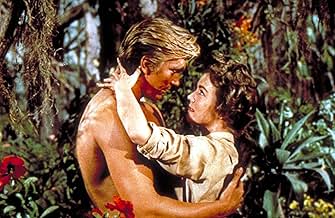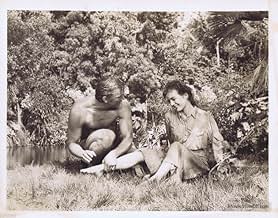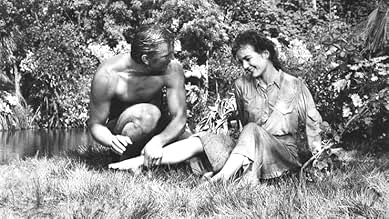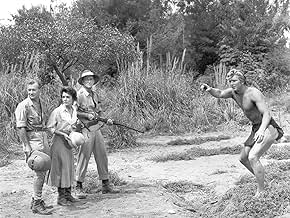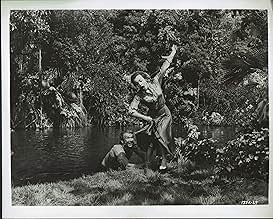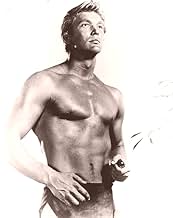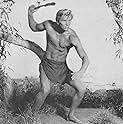- Director
- Writers
- All cast & crew
- Production, box office & more at IMDbPro
Featured reviews
This 1959 Tarzan film is a real curio on several levels. For one thing, it is far and away the lowest-budget Tarzan film ever made, and therefore contains some irresistibly silly footage and special effects. Secondly, it marks the one and only occasion that the ape man was played by ex-basketballer Denny Miller. In spite of the massive critical mauling the film received, Miller is not really as awful in the role as people have always maintained. Given a better film in which to appear, it's conceivable that he may have made more appearances as Tarzan and enjoyed a measure of success in the part. Thirdly, the film has one of the most bizarrely ill-fitting scores ever... provided by jazz supremo Shorty Rogers. These mismatched ingredients actually lend the film a sort of innocent charm. It's definitely bad cinema, but there have been much worse films over the years (heck, there have been worse Tarzan films – anyone seen the 1981 Bo Derek debacle?)
English explorer James Parker (James Parker) heads into the heart of Africa in search of a legendary elephant's graveyard. Among his travelling companions are his daughter Jane (Joanna Barnes) and her fiancée Harry Holt (Cesare Danova). Their journey is fraught with danger, what with hostile landscapes, jungle tribes and savage animal attacks. Eventually, however, the party successfully negotiate their way deeper into uncharted territory. Jane is separated from her friends and winds up in the company of a primitive man-of-the-jungle, the ape man of the title, Tarzan (Denny Miller). Her father is determined to find his daughter and save her from this half-animal jungle man, but it is not long before Jane has begun to fall in love with her captor .
There are some pretty embarrassing moments during the course of this movie, of that there can be no argument. The fire sequence in the pygmy village is so fake and cheap that it is nothing short of terrible. The scene in which Tarzan fights against a leopard contains some absolutely hilarious close-ups of Miller tussling with what appears to be a stuffed toy. And worst of all is the frequent tinted footage stolen from the 1932 Johnny Weismuller film of the same title – even the smallest of children will be able to tell that these scenes are not shot in Technicolor like the rest of the film (hell, occasionally Weismuller's face can be seen as plain as day!) Having said all that, I can't bring myself to be as derogatory about this film as some of the previous reviewers have been. For me, Barnes, Douglas and Danova do a passable enough job with their roles, and the film's brief 82 minute duration is crammed with incident. One needs to remember that when director Joseph M. Newman and producer Al Zimbalist actually set out to make this film, they weren't trying to re-do Shakespeare. A simple jungle adventure is what they had in mind, and to some extent a simple jungle adventure is precisely what they've given us. Tarzan The Ape Man (1959) is an enjoyably bad time filler – if nothing else, it has enough innocent charm and unintentional laughs to bring a smile to our faces in these weary and cynical times.
English explorer James Parker (James Parker) heads into the heart of Africa in search of a legendary elephant's graveyard. Among his travelling companions are his daughter Jane (Joanna Barnes) and her fiancée Harry Holt (Cesare Danova). Their journey is fraught with danger, what with hostile landscapes, jungle tribes and savage animal attacks. Eventually, however, the party successfully negotiate their way deeper into uncharted territory. Jane is separated from her friends and winds up in the company of a primitive man-of-the-jungle, the ape man of the title, Tarzan (Denny Miller). Her father is determined to find his daughter and save her from this half-animal jungle man, but it is not long before Jane has begun to fall in love with her captor .
There are some pretty embarrassing moments during the course of this movie, of that there can be no argument. The fire sequence in the pygmy village is so fake and cheap that it is nothing short of terrible. The scene in which Tarzan fights against a leopard contains some absolutely hilarious close-ups of Miller tussling with what appears to be a stuffed toy. And worst of all is the frequent tinted footage stolen from the 1932 Johnny Weismuller film of the same title – even the smallest of children will be able to tell that these scenes are not shot in Technicolor like the rest of the film (hell, occasionally Weismuller's face can be seen as plain as day!) Having said all that, I can't bring myself to be as derogatory about this film as some of the previous reviewers have been. For me, Barnes, Douglas and Danova do a passable enough job with their roles, and the film's brief 82 minute duration is crammed with incident. One needs to remember that when director Joseph M. Newman and producer Al Zimbalist actually set out to make this film, they weren't trying to re-do Shakespeare. A simple jungle adventure is what they had in mind, and to some extent a simple jungle adventure is precisely what they've given us. Tarzan The Ape Man (1959) is an enjoyably bad time filler – if nothing else, it has enough innocent charm and unintentional laughs to bring a smile to our faces in these weary and cynical times.
WE'VE NOTICED FOR some time how the Hollywood crowd loves revisionism. Take for example: in FRANKENSTEIN (1818), author Mary Wollstonecroft Shelley named the main character Victor Frankenstein; yet for some unknown reason, UNIVERSAL PICTURES made his given name "Henry". To further complicate matters, they gave him a friend named "Victor !" In the 1942 Serial SPY SMASHER, Republic Studios gave the alter ego Alan Armstrong a twin brother "Jack" , that he never had in the Fawcett publication's WHIZ COMICS. In 1937, the same studio did a real number of revision in the DICK TRACY Serial by making him a G Man, making a "Gwen" his girlfriend and disposing of Tracy's comic page partner, Pat Patton for a "Mike Mc Gurk comic relief.
AS FOR OUR indictment of Metro Goldwyn Mayer, we call your attention to Tarzan's mate, Jane. In the original stories, author Edgar Rice Burroughs gave us Jane Porter, an American from Baltimore. The MGM version made her "Jane Parker", an English woman of Noble blood. Co figure. (and thanks for letting me get this gripe off my chest!)
AS FOR THIS 1959 remake of the 1932 Johnny Weissmuller/Maureen O'Sullivan original, all we can say is thumbs down. The limited budget shows, regardless of Techincolor; which no Johnny Weissmuller vehicle had. In a way it may have been an indicator of how the mighty Metro Goldwyn Mayer had fallen from its high perch in tinsel town.
TO ITS CREDIT, this film stuck very close to the original story, albeit in a somewhat updated version. The characterization of African Natives was somewhat upgraded, giving so many much more personality than the thin, shallow portrayals in the past. The movie starred newcomer Denny Miller and Joanna Barnes; who had enough talent for the roles. But we needn't remind you that they were no Weissmuller/O'Sullivan combo.
ANY POSITIVES THAT one may find are all too quickly undermined by the extensive use of now tinted, old footage from thr '32 original. In some scenes (particularly when Tarzan fights and kills the giant Crocodile, it is obvious that it's really Weissmuller or a very close double.
AS FOR OUR indictment of Metro Goldwyn Mayer, we call your attention to Tarzan's mate, Jane. In the original stories, author Edgar Rice Burroughs gave us Jane Porter, an American from Baltimore. The MGM version made her "Jane Parker", an English woman of Noble blood. Co figure. (and thanks for letting me get this gripe off my chest!)
AS FOR THIS 1959 remake of the 1932 Johnny Weissmuller/Maureen O'Sullivan original, all we can say is thumbs down. The limited budget shows, regardless of Techincolor; which no Johnny Weissmuller vehicle had. In a way it may have been an indicator of how the mighty Metro Goldwyn Mayer had fallen from its high perch in tinsel town.
TO ITS CREDIT, this film stuck very close to the original story, albeit in a somewhat updated version. The characterization of African Natives was somewhat upgraded, giving so many much more personality than the thin, shallow portrayals in the past. The movie starred newcomer Denny Miller and Joanna Barnes; who had enough talent for the roles. But we needn't remind you that they were no Weissmuller/O'Sullivan combo.
ANY POSITIVES THAT one may find are all too quickly undermined by the extensive use of now tinted, old footage from thr '32 original. In some scenes (particularly when Tarzan fights and kills the giant Crocodile, it is obvious that it's really Weissmuller or a very close double.
From 1959 until 1981 this film reigned as champion of the "Bad" Tarzan films. It then relinquished it's title to the 1981 movie of the same name with Bo Derek swinging on the vine. Denny Miller is Tarzan and borrows the yell from the Johnny Weissmuller films. Of course a must see for any Tarzan film fan. AMC ran it during their Tarzanathon a while back. Miller was not the worst Tarzan ever he just happened to be in a bad picture about the legendary ape man. Take a look if you want but it helps if your a real Tarzan fan.
Rather than go to the unnecessary trouble and expense of hiring actors nd shooting lots of new footage to make his film, producer Al Zimbalist cast Denny Miller , a UCLA basketball star with no acting experience, as Tarzan....then,larded the film with as much stock jungle footage from the 1950 film "king solomans mines" as he could. And when that ran out, he used footage from the original 1932 classic "tarzan the ape man" starring Johnny Weissmuller.
of course there was the small problem that Zimbalist's film was filmed in color and weissmullers was in black and white...but zimbaslist got around that by having the black and white footage tinted to make it appear as if it had been filmed in Technicolor, like the rest of the movie. but it didn't. it didn't even look like denny miller. in one scene you can actually see johnny weissmullers face clearly as he fights a crocodile.
What little footage zimbalist did bother to flm was awful.in one important action sequence, real footage of an animal trainer dressed as Tarzan wrestling with a live leapard was combined with shots of miller wrestling with a large stuffed animal complete with close ups of its face, plastic fangs, button eyes and all!
bad bad bad bad bad
of course there was the small problem that Zimbalist's film was filmed in color and weissmullers was in black and white...but zimbaslist got around that by having the black and white footage tinted to make it appear as if it had been filmed in Technicolor, like the rest of the movie. but it didn't. it didn't even look like denny miller. in one scene you can actually see johnny weissmullers face clearly as he fights a crocodile.
What little footage zimbalist did bother to flm was awful.in one important action sequence, real footage of an animal trainer dressed as Tarzan wrestling with a live leapard was combined with shots of miller wrestling with a large stuffed animal complete with close ups of its face, plastic fangs, button eyes and all!
bad bad bad bad bad
Jane Parker travels to Africa to reunite with her father Col. James Parker. Business has been going badly due to tribal conflicts and he has not been sending money to his daughter. Without money, she got dumped and has no place in society. She helps a local which only exacerbates the tribal conflict. Father and daughter escape. Along the way, they are attacked by rampaging elephants and Tarzan rescues Jane.
Apparently, this was cobbled together from old footage and filming on the backlot. I like a lot of the animal footage which are most likely previously filmed. The footage with the actors is less compelling. The movie deteriorates after the rescue. Holt and her father turn into douches. After getting shot at, Tarzan is incredibly understanding. He should think that Jane had been kidnapped and they're trying to kill him. It becomes a knot of conflicting interest and no happy flow. Characters would fight one minute and work together the next. The writing is messy. Also, the ending has a distasteful aspect. It's downhill slide to the finish.
Apparently, this was cobbled together from old footage and filming on the backlot. I like a lot of the animal footage which are most likely previously filmed. The footage with the actors is less compelling. The movie deteriorates after the rescue. Holt and her father turn into douches. After getting shot at, Tarzan is incredibly understanding. He should think that Jane had been kidnapped and they're trying to kill him. It becomes a knot of conflicting interest and no happy flow. Characters would fight one minute and work together the next. The writing is messy. Also, the ending has a distasteful aspect. It's downhill slide to the finish.
Did you know
- TriviaDirectly steals story points, footage, and sound from 1950's King Solomon's Mines.
- GoofsThe elephant that is shown charging soon before Jane is picked up by Tarzan is an Asian elephant, not an African elephant. The fake large ears are noticeable as Tarzan says, "Un-ga-wa" to the elephant to lift Jane and himself onto it; they are almost falling off. Asian elephants are less aggressive than African, and are more easily trained. Also, they don't live in Africa.
- Quotes
Col. James Parker: Has any woman ever meant anything to you?
Harry Holt: All women mean something to me!
- ConnectionsEdited from Tarzan, l'homme singe (1932)
- How long is Tarzan, the Ape Man?Powered by Alexa
Details
- Release date
- Country of origin
- Language
- Also known as
- Tarzan, the Ape Man
- Filming locations
- Production company
- See more company credits at IMDbPro
Box office
- Gross US & Canada
- $1,438,800
- Gross worldwide
- $3,727,800
- Runtime1 hour 22 minutes
- Color
- Aspect ratio
- 1.85 : 1
Contribute to this page
Suggest an edit or add missing content

Top Gap
By what name was Tarzan, l'homme-singe (1959) officially released in Canada in English?
Answer

